OUTLINE
Target area
[Phat Sanday Village]
The Kingdom of Cambodia is a country in Southeast Asia with a rich terrain including lowland plains, Mekong Delta, mountainous areas and coastline of the Gulf of Thailand. To the northwest is Angkor Wat, a vast stone temple complex built during the Khmer Empire.
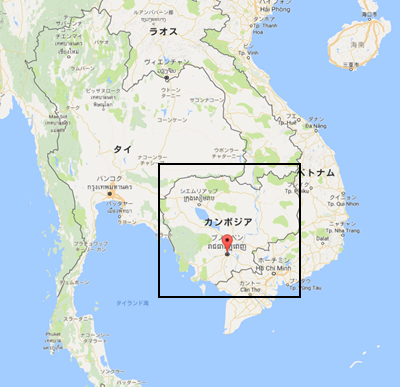
The area of the lake is about four times larger than Lake Biwa of Japan
in the dry season, but it expands six times in the rainy season so as to
be 24 times larger than Lake Biwa.
There are many fishing households around Tonle Sap Lake, some of whom live
in boats with houses floating on the lake. Many of these boats gather to
form villages, and people live in village units. Pat Sandy Village in Kompong
Thom Province, which was the target of this project, is a floating village
of about 1,000 households located on the lake bottom in the southeastern
part of Lake Tonle Sap. Most of the villagers live by fishing, while others
work in schools, sales, restaurants and other services within the commune.
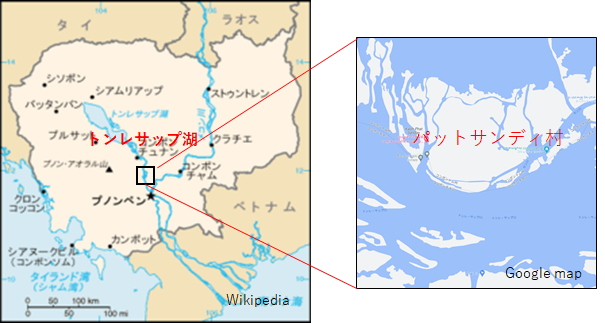
Initially, we planned to target Cunok Tru village in Kampong Chhnang Province,
which we had previously investigated. Since Kampong Chhnang Province is
planning to relocate the villagers to the land instead of abolishing the
water settlements, therefore, we targeted Pat Sandy Village in Kampong
Thom Province, which has no relocation plan.
To get to Patsandy village, first drive north from Phnom Penh city for
about 3 hours to a port in Chnok Tru village. Since Patsandi village is
not connected by northern land, it takes about 10 minutes by boat from
the port. Adjacent to wetlands protected by the Ramsar Convention, a ranger
Office of the Ministry of Environment is located in the village.
[Living in floating village]
You can buy things at the shop on the boat in the floating village, and
you can buy any things normally when you go on land. The villagers use
PET bottled beverages and drinking water from bottle servers for drinks,
and use plastic cups and straws for coffee and juice. Fish and meat are
sold naked, but they are brought back in plastic bags, and imported foods
and sweets are wrapped in plastic. That's not all. The fishing nets and
lines are also made of plastic. In this way, plastic products are as essential
to the lives of people living in water settlements as they are to people
living on land.
So what do villagers do after using plastic products?
[Whereabout of waste in the village]
For garbage and sewage, littering and dumping onto the surface of the lake is common, as there is no waste collection service and no drainage facilities. Organic matter discarded in the lake becomes food for fish and plankton, and the remaining is decomposed by microorganisms and disappears, but plastic waste is not so. As I will explain later, almost of plastic products have a long lifespan, so when thrown into the water, the lighter ones float on the surface of the lake, while the heavier ones sink to the bottom of the lake, and are staying for years, decades, or some hundreds of years. Lake Tonle Sap swells during the rainy season, and the water carries plastic waste downstream. It may eventually flow into the Pacific Ocean through the Tonle Sap river and Mekong river.
During the dry season, the lake shore recedes and the lake bottom is exposed.
Many plastic bags and PET bottles are scattered there and no place to step.
However, the villagers do not seem to clean it. Why do the people who live
there think nothing of the landscape littered with plastic waste? From
what I heard, everyone thinks that when the rainy season comes, the lake
water will wash away the plastic waste somewhere, so they can just wait.
It is thought that littering has become a habit, and people have become
accustomed to the sight of plastic litter every year.
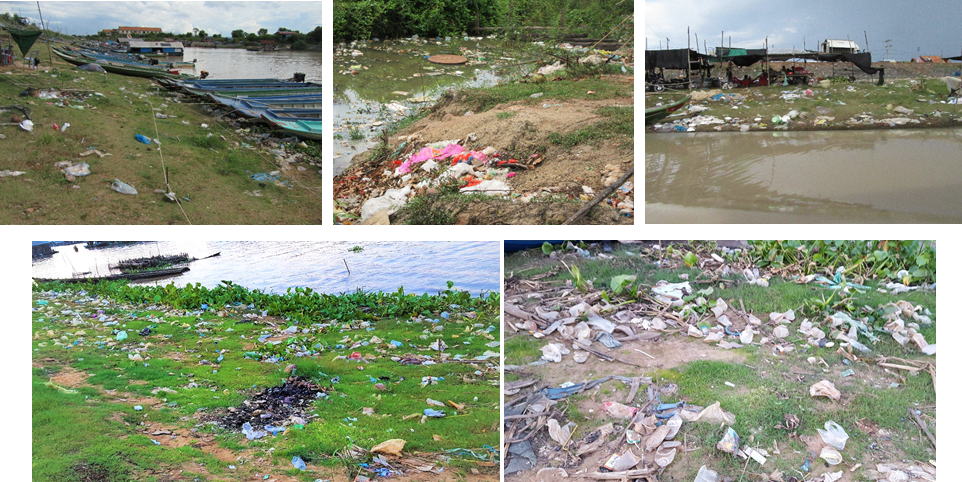
Plastic waste in Chnok Tru Village
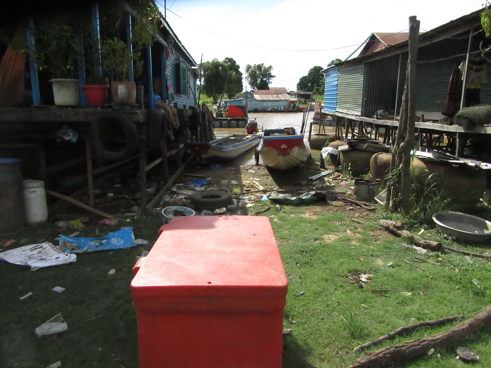
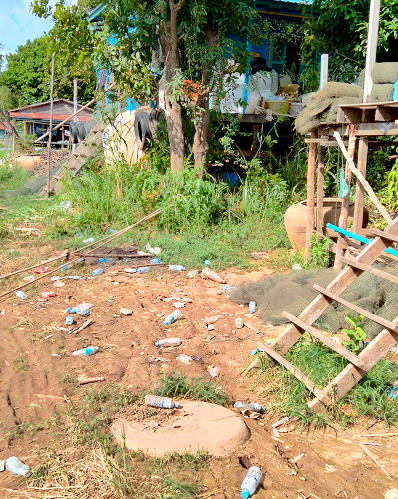
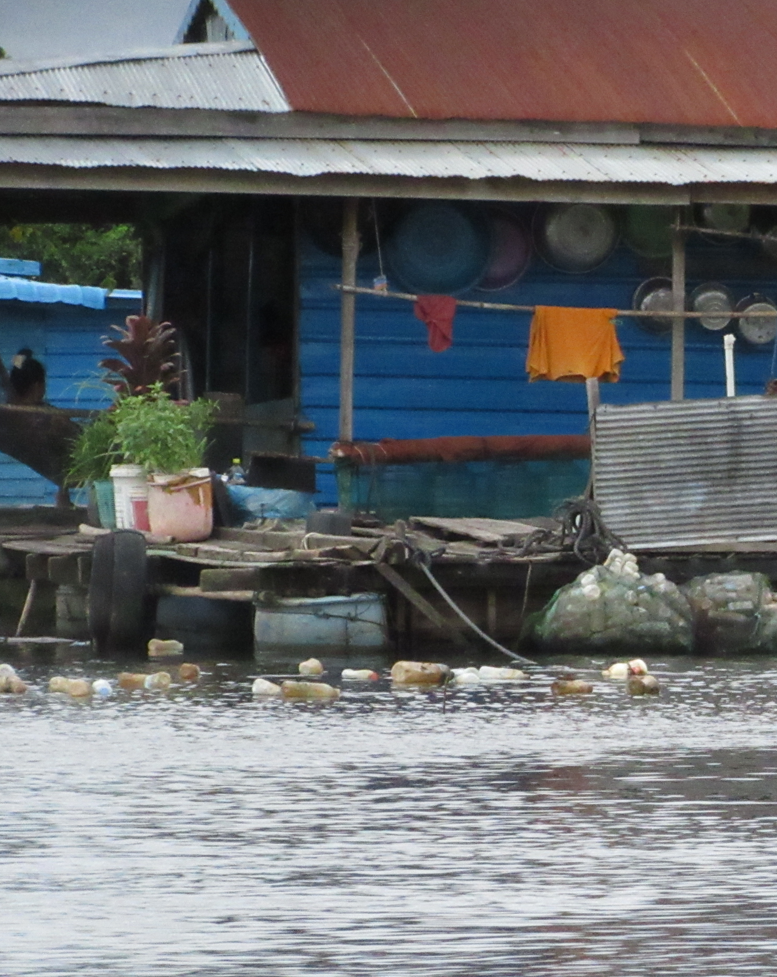
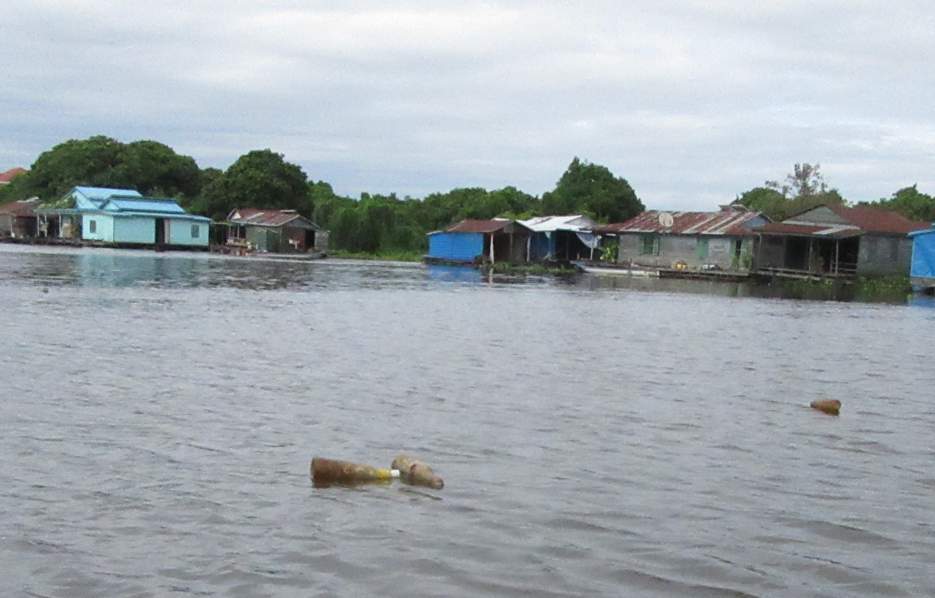
Plastic waste in Phat Saday Village
[Waste disposal in developing countries]
n Japan, if you put out your garbage bag in the morning, a truck from the city hall will come to pick it up for you. Japan's waste disposal law stipulates that household waste should be properly disposed of under the responsibility of local governments. However, developing countries is not always same like Japan. Waste disposal is simply a matter of collecting it for taking to a disposal site and dumping. IIn addition, in the cases where local governments give private waste disposal companies the responsibility of providing waste collection services and collecting disposal fees all at once, private businesses may neglect collection, or refuse to collect waste in areas where they do not pay the disposal fee. It can not be expected that private company collect the waste in the floating village due to high cost in collecting waste by boat. So what should we do? In order to prevent the increase of marine plastic litter, it is important not to dump plastic litter into lakes.
Project
[Purpose]
It is necessary to eliminate the dumping of plastic waste into rivers and
lakes that leads to marine plastic in the world. In particular, we think
it is a problem that the waste having no place to go in our daily lives
is thrown into water bodies. This is a waste management issue. Even in
areas where waste collection services are not economically viable, we must
prevent the dumping of plastic garbage onto the surface of the water. However,
not throwing it into the water means that we have to prepare some other
way to deal with it. Recycling plastic waste is a reasonable method, but
it is necessary not only to separate plastic waste at home, but also to
consider how to collect it and put it in the recycling flow.
In order to get households who used to throw waste into the lake to sort
their plastic waste, it is necessary to provide a menu for education and
enlightenment. I think it would be better if there was a motive of sorting
out things like, "Let's cooperate because there's something wrong."
If only a small group of volunteers cooperate in discernment, they will
eventually grow tired of it and quit. If the entire village starts the
separation and recycling, the will will be unified and the sorting action
will continue for a long time. For that reason, it is necessary for the
village's self-governing organization to stand up and lead the separation
and recycling. From the above perspectives, we decided to support the construction
of a system that is suitable for the local community, emphasizing that
the project is a "participatory type" of plastic waste separation
and recycling.
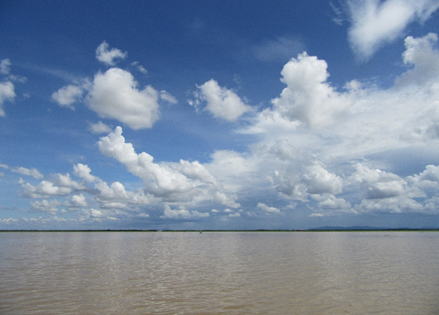
Tonle Sap Lake
[Project Plan]
The plan is explained along the business approach diagram.
- [Baseline survey]
- First, as a baseline survey to understand the current situation, we investigated the amount and type of plastic waste generated. We also interviewed villagers about plastic waste. During the interview, we asked about the villagers' knowledge of plastics, their awareness of environmental problems caused by plastic waste, and their willingness to cooperate in sorting plastic waste.
- [Investigation of recyclingroutes]
- We conducted a survey on existing plastic recycling routes. Even before the project, PET bottles were collected by private collectors as valuables. In addition, collectors transported the collected PET bottles to Chnok Tru village and sold them to traders (junk shops) there. Therefore, we interviewed collectors and junk shops about purchase prices and sales destinations. Based on the information collected above, we examined a viable separation/recycling system.
- [Separation promotion team training]
- We will recruit members who will strongly promote the separation and recycling of plastic waste in the village, and conduct education and enlightenment as a separation promotion team. The plan envisioned that the promotion members would be invited to Japan for training (training in Japan), and that they would sort out recyclable waste at home, pre-treat local governments, and visit private factories where plastic recycling was carried out. However, it did not go as planned and the training ended up in Cambodia. More on this later.
- [Creation of education and enlightenment materials]
- We created teaching materials for education and enlightenment for the training of the garbage separation promotion team and the garbage separation instruction for the villagers. We will include the necessary knowledge of plastics, environmental issues, separation methods, collection methods, etc. We are also preparing teaching materials for children so that children can learn about the problem of plastics in elementary schools.
- [Holding events]
- For plastic classification, recycling, we performed enlightenment event that we gathered citizens. We also held a cleanup event in conjunction with World Environment Day in June.
- [Launching of the separation activities]
- (Near future)We will start the separation and recycling by raising the village. When the preparations are complete, the entire village will start the plastic waste separation and recycling project all at once. After that, we will conduct a survey on the villagers' cooperation in sorting and the effect of sorting, and evaluate the effect of the project.
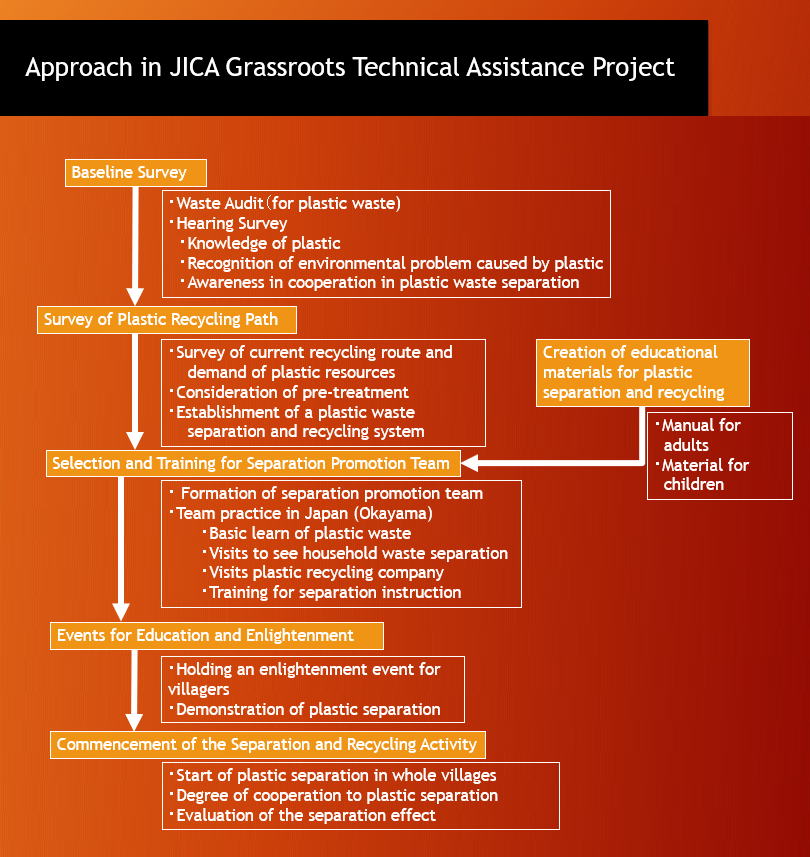
「Start and end of the project」
project started in March 2022. It is scheduled to end in April 2024.